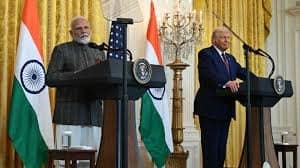
India and the United States are actively engaged in negotiations to establish a comprehensive trade agreement aimed at enhancing bilateral economic relations. Recent discussions have focused on reducing tariffs and addressing non-tariff barriers. A significant development occurred from March 26 to 29, 2025, when officials from both nations convened in New Delhi to advance these talks, with the goal of finalizing the first phase of the agreement by autumn.
In a bid to meet U.S. concerns over high tariffs, India has proposed lowering import duties on various American agricultural products and is considering cuts on liquefied natural gas (LNG) taxes. Specific measures include reducing tariffs on items like bourbon whiskey, luxury cars, solar cells, and machinery, aiming to make these products more accessible in the Indian market.
U.S. President Donald Trump has expressed a desire for a “fair” trade relationship with India, highlighting the need to address the substantial trade deficit, which stood at $50 billion in 2023. During a meeting with Prime Minister Narendra Modi, Trump emphasized the importance of reducing India’s import tariffs, describing them as “very unfair and strong.” He also suggested that higher U.S. tariffs on Indian goods could be imposed if progress is not made in negotiations.
Both leaders have set an ambitious target to more than double bilateral trade to $500 billion by 2030. To achieve this, they are exploring various avenues, including increasing U.S. energy and defense exports to India. Additionally, discussions are underway to enhance defense cooperation, with the U.S. considering the sale of advanced military equipment, such as F-35 stealth fighters, to India.
In response to U.S. concerns over trade barriers, India has taken proactive steps, such as committing to raise energy imports from the U.S. and eliminating the 6% tax on digital advertisements to attract U.S. tech companies. These measures are part of India’s strategy to address U.S. criticisms of its tariff policies and to strengthen trade relations.
However, challenges persist. President Trump has reiterated threats to impose reciprocal tariffs on Indian goods starting April 2, 2025, if significant progress is not made in reducing trade barriers. He has criticized India’s high tariffs, referring to the country as a “tariff king,” and has warned that the U.S. will match these tariffs if they are not lowered.
As negotiations continue, both nations are working to reconcile differences and establish a trade framework that benefits their respective economies. The outcome of these discussions will have significant implications for global trade dynamics, given the economic stature of both India and the United States.
By BHARAT GLOBAL TIME





